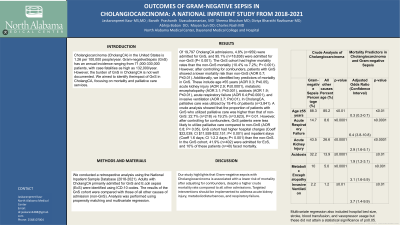Tuesday Poster Session
Category: Biliary/Pancreas
P3486 - Outcomes of Gram-Negative Sepsis in Cholangiocarcinoma: A National Inpatient Study From 2018-2021
Tuesday, October 29, 2024
10:30 AM - 4:00 PM ET
Location: Exhibit Hall E

Has Audio

Barath Prashanth Sivasubramanian, MD
Northeast Georgia Medical Center
Gainesville, GA
Presenting Author(s)
Barath Prashanth Sivasubramanian, MD1, Diviya Bharathi Ravikumar, MBBS2, Abijha Boban, DO, MBA3, Moyan Sun, DO1, Jaskaranpreet Kaur, MD, MS4, Sheena Bhushan, MD1, Charles Nash, MD1
1Northeast Georgia Medical Center, Gainesville, GA; 2ESIC Medical College and Hospital, Chennai, Tamil Nadu, India; 3Northeast Georgia Medical Center, Atlanta, GA; 4North Alabama Medical Center, Florence, AL
Introduction: Cholangiocarcinoma (CholangCA) in the United States is 1.26 per 100,000 people/year. Gram-negative Sepsis (GnS) has an annual incidence ranging from 71,000-330,000 patients, with case fatalities as high as 132,000/year. However, the burden of GnS in CholangCA is not well documented. We aimed to identify the impact of GnS in CholangCA, focusing on mortality and palliative care services.
Methods: We conducted a retrospective analysis using the National Inpatient Sample Database (2018-2021). Adults with CholangCA primarily admitted for GnS and E.coli sepsis (EcS) were identified using ICD-10 codes. The results of the GnS cohort were compared with those of all other causes of admission (non-GnS). Analysis was performed using propensity matching and multivariate regression.
Results: Of 19,797 CholangCA admissions, 4.8% (n=959) were admitted for GnS, and 95.1% (n=18,838) were admitted for non-GnS (P< 0.001). The GnS cohort had higher mortality rates than the non-GnS mortality (10.4% vs 7.2%; P< 0.001). However, after controlling for confounders, patients with GnS showed a lower mortality risk than non-GnS (AOR 0.7; P≤0.01). Additionally, we identified key predictors of mortality in GnS. These include age ≥55 years (AOR 0.3; P≤0.05), acute kidney injury (AOR 2.9; P≤0.0001), metabolic encephalopathy (AOR 3.1; P≤0.001), acidosis (AOR 1.9; P≤0.01), acute respiratory failure (AOR 6.4; P≤0.0001), and invasive ventilation (AOR 3.7; P≤0.01). In CholangCA, palliative care was utilized by 19.4% of patients (n=3,841). A crude analysis showed that the proportion of patients with GnS who utilized palliative care was higher than that of non-GnS: 22.7% (n=218) vs 19.2% (n=3,623), P< 0.01. However, after controlling for confounders, GnS patients were less likely to utilize palliative care compared to non-GnS (AOR 0.8; P< 0.05). GnS cohort had higher hospital charges (Coeff $22,039; CI $11,928-$32,151; P< 0.001) and inpatient stays (Coeff 1.6 days; CI 1-2.2 days; P< 0.001) than the non-GnS. In the GnS cohort, 41.9% (n=402) were admitted for EcS, and 10% of these patients (n=40) faced mortality.
Discussion: Our study highlights that Gram-negative sepsis with Cholangiocarcinoma is associated with a lower risk of mortality after adjusting for confounders, despite a higher crude mortality rate compared to all other admissions. Targeted interventions should be implemented to address acute kidney injury, metabolic disturbances, and respiratory failure.
Note: The table for this abstract can be viewed in the ePoster Gallery section of the ACG 2024 ePoster Site or in The American Journal of Gastroenterology's abstract supplement issue, both of which will be available starting October 27, 2024.
Disclosures:
Barath Prashanth Sivasubramanian, MD1, Diviya Bharathi Ravikumar, MBBS2, Abijha Boban, DO, MBA3, Moyan Sun, DO1, Jaskaranpreet Kaur, MD, MS4, Sheena Bhushan, MD1, Charles Nash, MD1. P3486 - Outcomes of Gram-Negative Sepsis in Cholangiocarcinoma: A National Inpatient Study From 2018-2021, ACG 2024 Annual Scientific Meeting Abstracts. Philadelphia, PA: American College of Gastroenterology.
1Northeast Georgia Medical Center, Gainesville, GA; 2ESIC Medical College and Hospital, Chennai, Tamil Nadu, India; 3Northeast Georgia Medical Center, Atlanta, GA; 4North Alabama Medical Center, Florence, AL
Introduction: Cholangiocarcinoma (CholangCA) in the United States is 1.26 per 100,000 people/year. Gram-negative Sepsis (GnS) has an annual incidence ranging from 71,000-330,000 patients, with case fatalities as high as 132,000/year. However, the burden of GnS in CholangCA is not well documented. We aimed to identify the impact of GnS in CholangCA, focusing on mortality and palliative care services.
Methods: We conducted a retrospective analysis using the National Inpatient Sample Database (2018-2021). Adults with CholangCA primarily admitted for GnS and E.coli sepsis (EcS) were identified using ICD-10 codes. The results of the GnS cohort were compared with those of all other causes of admission (non-GnS). Analysis was performed using propensity matching and multivariate regression.
Results: Of 19,797 CholangCA admissions, 4.8% (n=959) were admitted for GnS, and 95.1% (n=18,838) were admitted for non-GnS (P< 0.001). The GnS cohort had higher mortality rates than the non-GnS mortality (10.4% vs 7.2%; P< 0.001). However, after controlling for confounders, patients with GnS showed a lower mortality risk than non-GnS (AOR 0.7; P≤0.01). Additionally, we identified key predictors of mortality in GnS. These include age ≥55 years (AOR 0.3; P≤0.05), acute kidney injury (AOR 2.9; P≤0.0001), metabolic encephalopathy (AOR 3.1; P≤0.001), acidosis (AOR 1.9; P≤0.01), acute respiratory failure (AOR 6.4; P≤0.0001), and invasive ventilation (AOR 3.7; P≤0.01). In CholangCA, palliative care was utilized by 19.4% of patients (n=3,841). A crude analysis showed that the proportion of patients with GnS who utilized palliative care was higher than that of non-GnS: 22.7% (n=218) vs 19.2% (n=3,623), P< 0.01. However, after controlling for confounders, GnS patients were less likely to utilize palliative care compared to non-GnS (AOR 0.8; P< 0.05). GnS cohort had higher hospital charges (Coeff $22,039; CI $11,928-$32,151; P< 0.001) and inpatient stays (Coeff 1.6 days; CI 1-2.2 days; P< 0.001) than the non-GnS. In the GnS cohort, 41.9% (n=402) were admitted for EcS, and 10% of these patients (n=40) faced mortality.
Discussion: Our study highlights that Gram-negative sepsis with Cholangiocarcinoma is associated with a lower risk of mortality after adjusting for confounders, despite a higher crude mortality rate compared to all other admissions. Targeted interventions should be implemented to address acute kidney injury, metabolic disturbances, and respiratory failure.
Note: The table for this abstract can be viewed in the ePoster Gallery section of the ACG 2024 ePoster Site or in The American Journal of Gastroenterology's abstract supplement issue, both of which will be available starting October 27, 2024.
Disclosures:
Barath Prashanth Sivasubramanian indicated no relevant financial relationships.
Diviya Bharathi Ravikumar indicated no relevant financial relationships.
Abijha Boban indicated no relevant financial relationships.
Moyan Sun indicated no relevant financial relationships.
Jaskaranpreet Kaur indicated no relevant financial relationships.
Sheena Bhushan indicated no relevant financial relationships.
Charles Nash indicated no relevant financial relationships.
Barath Prashanth Sivasubramanian, MD1, Diviya Bharathi Ravikumar, MBBS2, Abijha Boban, DO, MBA3, Moyan Sun, DO1, Jaskaranpreet Kaur, MD, MS4, Sheena Bhushan, MD1, Charles Nash, MD1. P3486 - Outcomes of Gram-Negative Sepsis in Cholangiocarcinoma: A National Inpatient Study From 2018-2021, ACG 2024 Annual Scientific Meeting Abstracts. Philadelphia, PA: American College of Gastroenterology.
